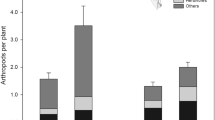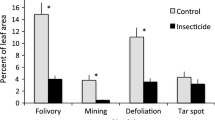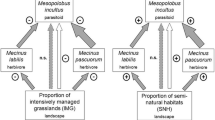Abstract
We examined the potential of a leaf roller to indirectly influence a community of arthropods. Two mite species are the key herbivores on papaya leaves in Hawaii: a spider mite, Tetranychus cinnabarinus Boisduval, and an eriophyid mite, Calacarus flagelliseta, which induces upward curling of the leaf margin at the end of the summer when populations reach high densities. A survey and three manipulative field experiments demonstrated that (1) leaf rolls induce a consistent shift in the spatial distribution of spider mites and their predators, the coccinellid Stethorus siphonulus Kapur, the predatory mites Phytoseiulus spp., and the tangle-web building spider Nesticodes rufipes Lucas; (2) the overall abundance of spiders increases on leaves with rolls; (3) the specialist predators Stethorus and Phytoseiulus inhabit the rolls in response to their spider mite prey; and (4) the spider inhabits the rolls in response to the architecture of the roll itself. This study shows the importance of indirect effects in structuring a terrestrial community of herbivores.





Similar content being viewed by others
References
Altegrim O (1992) Mechanisms regulating bird predation on a herbivorous larva guild in boreal coniferous forests. Ecography 15:19–24
Barcelo JA (1981) Photoeffects of visible and ultraviolet radiation on the two-spotted spider mite, Tetranychus urticae. Photochem Photobiol 33:703–706
Barreto M, Barreto P, D'Alessandro A (1987) Predation on Rhodnius prolixus (Hemiptera: Reduviidae) by the spider Theridion rufipes (Araneae: Theridiidae). J Med Entomol 24:115–116
Cappuccino N (1993) Mutual use of leaf shelters by lepidopteran larvae on paper birch. Ecol Entomol 18:287–292
Castagnoli M (1996) Ornamental coniferous and shade trees. In: Lindquist EE, Sabelis MW, Bruin J (eds) Eriophyoid mites: their biology, natural enemies and control. (World Crop Pest Series, vol 6) Elsevier, Amsterdam, pp 661–671
Cushing BS, LeBeck LM (1994) Foraging in cockroach sticky traps by the spider Nesticodes rufipes Lucas (Araneae: Theridiidae): a super food resource. Acta Arachnol 43:49–55
Damman H (1987) Leaf quality and enemy avoidance by the larvae of a pyralid moth. Ecology 68:88–97
Damman H (1993) Patterns of interactions among herbivore species. In: Stamp NE, Casey TM (eds) Caterpillars: ecological and evolutionary constraints on foraging. Chapman and Hall, New York, pp 132–169
Esguerra NM, Haramoto FH (1980) Distribution and population of papaya carmine spider mites Tetranychus cinnabarinus and their predators. Ann Trop Res 3:135–148
Eubanks MD, Nesci KA, Petersen MK, Liu Z, Sanchez HB (1997) The exploitation of an ant-defended host-plant by a shelter-building herbivore. Oecologia 109:454–460
Fletchmann CHW, De Moraes GJ, Barbosa FR (2001) A new species of Calacarus keifer (Acari: Eriophyiodea) on papaya in northeastern Brazil. Zootaxa 5:1–5
Fox I (1998) Predation on Aedes aegypti (Diptera: Culicidae) by Theridion rufipes (Araneae: Theridiidae) in Puerto Rico. J Med Entomol 35:611–613
Frost SW (1959) Insect life and insect natural history. Dover, NY
Fukui A (2001) Indirect interactions mediated by leaf shelters in animal-plant communities. Popul Ecol 43:31–40
Greenstone MH (1984) Determinants of web spider species diversity: vegetation structural diversity vs. prey availability. Oecologia 62:299–304
Gunnarson B (1990) Vegetation structure and the abundance and size distribution of spruce-living spiders. J Anim Ecol 59:743–752
Halaj J, Ross DW, Moldenke AR (1998) Habitat structure and prey availability as predictors of the abundance and community organization of spiders in western Oregon forest canopies. J Arachnol 26:203–220
Halaj J, Ross DW, Moldenke AR (2000) Importance of habitat structure to the arthropod food web in Douglas-fir canopies. Oikos 90:139–152
Hazan A, Gerson U, Tahori AS (1973) Life history and life tables of the carmine spider mite. Acarologia 15:414–440
Heads PA, Lawton H (1985) Bracken, ant and extrafloral nectaries. III. How herbivores avoid ant predation. Ecol Entomol 10:29–42
Holtzer TO, Norman JM, Perring TM, Berry JS, Heintz JC (1988) Effects of microenvironment on dynamics of spider mite populations. Exp Appl Acarol 4:247–264
Hooks CRR, Johnson MW (2002) Lepidopteran pest populations and crop yield in row intercropped broccoli. Agric For Entomol 4:117–125
Janssen A, Pallini A, Venzon M, Sabelis MW (1998) Behaviour and indirect interactions in food webs of plant-inhabiting arthropods. Exp Appl Acarol 22:497–521
Jeppson LR, Keifer HH, Baker EW (1975) Mites injurious to economic plants. University of California Press, Berkeley, Calif.
JMP User's Guide, Version 4 (2000) SAS Institute Inc., Cary, NC
Jones CG, Lawton JH, Shachak M (1994) Organisms as ecosystem engineers. Oikos 69:373–386
Jones CG, Lawton JH, Shachak M (1997) Positive and negative effects of organisms as physical ecosystem engineers. Ecology 78:1946–1957
Keifer HH, Baker WE, Kono T, Delfinado M, Styer WE (1982) An illustrated guide to plant abnormalities caused by Eriophyid mites in North America (Agriculture Handbook No. 573) United States Department of Agriculture, Washington, DC
Martinsen GD, Floate KD, Waltz AM, Wimp GM, Whitham TG (2000) Positive interactions between leafrollers and other arthropods enhance biodiversity on hybrid cottonwoods. Oecologia 123:82–89
McNett BJ, Rypstra AL (2000) Habitat selection in a large orb-weaving spider: vegetational complexity determines site selection and distribution. Ecol Entomol 25:423–432
Olive CW (1982) Behavioral response of a sit-and-wait predator to spatial variation in foraging gain. Ecology 63:912–920
Polis GA, Winemiller KO (1996) Food webs: Integration of patterns and dynamics. Chapman and Hall, New York
Prasad V (1973) The role of Phytoseiulus macropilis (Banks) (Acarina: Phytoseiidae) in control of the spider mites in Hawaii. Acarologia 15:401–405
Putman WL (1970) Effects of water and high humidity on the European red mite, Panonychus ulmi (Acarina: Tetranychidae). Can Entomol 102:955–961
Raros ES, Haramoto FH (1974) Biology of Stethorus siphonolus Kapur (Coccinellidae: Coleoptera), a predator of spider mites, in Hawaii. Proc Hawaii Entomol Soc 21:457–465
Robinson JV (1981) The effect of architectural variation in habitat on a spider community: an experimental field. Ecology 62:73–80
Rosenheim JA, Corbett A (2003) Omnivory and the indeterminacy of predator function: can a knowledge of foraging behavior help? Ecology (in press)
Roy M, Brodeur J, Cloutier C (2002) Relationship between temperature and development rate of Stethorus punctillum (Coleoptera: Coccinellidae) and its prey Tetranychus mcdanieli (Acarina: Tetranychidae). Environ Entomol 31:177–187
Rypstra AL (1983) The importance of food and space in limiting web-spider densities: a test using field enclosures. Oecologia 59:312–316
Rypstra AL (1985) Aggregations of Nephila clavipes (L.) (Araneae, Araneidae) in relation to prey availability. J Arachnol 13:71–78
Rypstra AL (1986) Web spiders in temperate and tropical forests: relative abundance and environment correlates. Am Midl Nat 115:42–51
Rypstra AL, Carter PE, Balfour RA, Marshall SD (1999) Architectural features of agricultural habitats and their impact on the spider inhabitants. J Arachnol 27:371–377
Storey WM (1976) Papaya. In: Simmonds NW (ed) Evolution of crop plants. Longman, London, pp 21–24
Strauss SY (1991) Indirect effects in community ecology: their definition, study, and importance. Trends Ecol Evol 6:206–210
Sunderland K, Samu F (2000) Effects of agricultural diversification on the abundance, distribution, and pest control potential of spider: a review. Entomol Exp Appl 95:1–13
Tulisalo U (1974) Control of the two-spotted spider mite (Tetranychus urticae Koch) by high air humidity or direct contact with water. Ann Entomol Fenn 40:158–162
Westphal E, Manson DCM (1996) Feeding effects on host plants; gall formation and other distortion. In: Lindquist EE, Sabelis MW, Bruin J (eds) Eriophyoid mites: their biology, natural enemies and control. (World Crop Pest Series, vol 6) Elsevier, Amsterdam, pp 231–242
Wise DH (1993) Spider in ecological webs. Cambridge University Press, Cambridge
Wootton JT (1994) The nature and consequences of indirect effects in ecological communities. Annu Rev Ecol Syst 25:443–466
Acknowledgements
We thank Jo Diez, Cerruti Hooks, and the staff at the Poamoho Research Station of the University of Hawaii for their technical assistance. The manuscript was improved by comments from Cerruti Hooks, Sarina Jepsen, Gail Langellotto, Teresa Leonardo, Chris Matthews, Ken Spence, and Andy Zink. Eriophyid specimens were identified by James Amrine. This work was supported by a USDA-ARS grant for Minor Crops Research (Agreement no. 59-5320-9-226) and scholarships from the Natural Sciences and Engineering Research of Canada (NSERC) and the Fonds de Recherche sur la Nature et les Technologies du Québec to V.F.
Author information
Authors and Affiliations
Corresponding author
Rights and permissions
About this article
Cite this article
Fournier, V., Rosenheim, J.A., Brodeur, J. et al. Herbivorous mites as ecological engineers: indirect effects on arthropods inhabiting papaya foliage. Oecologia 135, 442–450 (2003). https://doi.org/10.1007/s00442-003-1212-9
Received:
Accepted:
Published:
Issue Date:
DOI: https://doi.org/10.1007/s00442-003-1212-9




